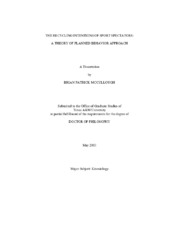| dc.description.abstract | Sport organizations have a negative impact on the environment but these
organizations have begun environmental initiatives to decrease their impact. Introducing
recycling programs not only offers visible environmental effort to decrease the
organization’s impact but such programs can provide financial savings for the
organization. Thus, my dissertation’s purpose is to understand the recycling intentions
of sport spectators by the means of three studies theoretically framed using the theory of
planned behavior.
Study 1 examined the recycling intentions of individuals after consuming plastic
water bottles within a campus environment. Participants were undergraduate students (N
= 144) enrolled in physical activity classes at a southwestern university in the United
States (males n=83, 57.6 percent, females n=60, 41.7 percent; mostly White n=96, 66.7 percent; age
M=19.6, SD=1.33). The results indicate that subjective norms (β = .29, p < .001) and
attitudes (β = .14, p < .05) towards recycling significantly predicted intentions to recycle
plastic bottles after consumption. Study 2 analyzed the recycling intentions within a sport context. Participants
(N=129) were adult spectators attending a weekend long youth baseball tournament in
the Southwest United States (women n=85, 65.9 percent, men n=40, 31.0 percent; predominately
White n=97, 75.2 percent; age M=44.47 years, SD=10.20). Similar to Study 1, subjective
norms (β = .27, p < .01) significantly predicted intentions to recycle. However, unlike
Study 1, perceived behavioral controls (β = .21, p < .05) were significant in predicting
intentions to recycle.
Lastly, Study 3 augmented my investigation to understand the unique context of
recycling intentions among sport spectators. I used qualitative research methods to
understand recycling intentions of spectators during a large scale-sporting event.
Participants (N=16) were adults that regularly attend college football games at a large
southwestern university (men n=10, women n=6; age M=37.44). The results indicate
that recycling within a sport context is unique considering the game day atmosphere.
Collectively, the findings from the three studies are discussed as to influence
decision-making policies within sport organizations to improve recycling programs and
to decrease the organization’s negative environmental impact. Finally, recommendations
are made for future research to understand recycling behaviors of sport spectators. | en |


